Selecting the Best 3D Concrete Printing Technology for Refugee Camp’s Shelter Construction Using Analytical Hierarchy Process: The Case of Syrian Refugees in Jordan
Abstract
1. Introduction
2. Refugees Shelter Weakness and Proposed Solutions
2.1. The Current Used Shelter
- -
- Interlocking steel tubes that make up the structure;
- -
- A door, which is covered in flat corrugated iron sheeting and insulated with 1.5 cm thick expanded polyethylene;
- -
- Steel window frame with two 180-degree opening window wings, 90 cm wide and 89 cm high, painted white.
- -
- Aluminum foam insulation for the walls and roof (15 mm thick Expanded Polyethylene), which is securely stretched and fastened to the shelter’s exterior frame with self-driving screws;
- -
- Reinforced concrete flooring (5 cm minimum thickness, reinforced with 6mm rebar, 30 cm spacing).
2.2. Current T Shelter Weakness
2.3. Proposed Shelter
2.4. Sheltering Camp Solutions
3. Selection of Decision Model
3.1. Selection Criteria
3.2. Candidates 3D Construction Technologies
3.2.1. Contour Crafting (CC)
3.2.2. D-Shape
3.2.3. Concrete Printing (CP)
4. Selecting Using the AHP Model
4.1. Model Construction
4.2. Criteria Pairwise Comparison
4.3. Sub-Criteria Pairwise Comparison
4.4. Alternative Pairwise Comparison
- Step 1: Numbers 3, 6, or 9 are assigned for each alternative on each of the comparison aspects, where 3 is assigned for the alternative that has the lowest performance in a particular comparison aspect compared with the other alternatives. Numbers 6 and 9 are assigned for the alternatives that have the middle and highest performance in this comparison aspect compared with other alternatives. It should be noticed that the printed layer thickness, resolution, and maximum wall height criteria have the same numbers reported in Table 2. Table 3 summarizes the numbers assigned to each sub-criteria that were used to conduct alternative pairwise comparisons.
- Step 2: The relative importance index (RIIA,B) between any two alternatives A and B for each comparison aspect is computed using Equation (5), and the corresponding assigned numbers listed in Table 3, (φA and φB represent the assigned numbers for alternatives A and B in terms of comparison aspect φ, respectively):
4.5. Inconsistency Test
4.6. Alternative Final Rank Determinations
4.7. Sensitivity Analysis
5. Cost and Feasibility Analysis of the Proposed Technology
5.1. Construction Cost Estimation Model
5.2. Cost Efficiency
6. Conclusions
Author Contributions
Funding
Data Availability Statement
Acknowledgments
Conflicts of Interest
References
- Karasapan, O. Future Development, Syrian Refugees in Jordan: A Decade and Counting. Available online: https://www.brookings.edu/blog/future-development/2022/01/27/syrian-refugees-in-jordan-a-decade-and-counting/ (accessed on 13 April 2023).
- ACAPS. Jordan Syrian Refugees. Available online: https://www.acaps.org/country/jordan/crisis/syrian-refugees (accessed on 13 April 2023).
- UNHCR. Refugee Camps. 2023. Available online: https://www.unhcr.org/jo/refugee-camps# (accessed on 13 April 2023).
- Abu Ramadan, R.F. Developing User-Informed Specifications for Refugee Shelters in Hot Dry Climates: A Study of Al Za’aatari Camp in Jordan; University of Salford: Salford, UK, 2017. [Google Scholar]
- Alshawawreh, L.; Smith, R.S.; Wood, J.B. Assessing the Sheltering Response in the Middle East: Studying Syrian Camps in Jordan. Int. J. Humanit. Soc. Sci. 2017, 11, 2016–2022. [Google Scholar]
- Alami, A.H.; Olabi, A.G.; Ayoub, M.; Aljaghoub, H.; Alasad, S.; Abdelkareem, M.A. 3D Concrete Printing: Recent Progress, Applications, Challenges, and Role in Achieving Sustainable Development Goals. Buildings 2023, 13, 924. [Google Scholar] [CrossRef]
- Lyu, F.; Zhao, D.; Hou, X.; Sun, L.; Zhang, Q. Overview of the Development of 3D-Printing Concrete: A Review. Appl. Sci. 2021, 11, 9822. [Google Scholar] [CrossRef]
- Wolfs, R.J.M.; Salet, T.A.M. Potentials and Challenges in 3D Concrete Printing. In Proceedings of the 2nd International Conference on Progress in Additive Manufacturing (Pro AM 2016), Singapore, 14–17 May 2016; pp. 8–13. [Google Scholar]
- Akelia, M. Evaluating the Feasibility of Building Refugee Shelters with 3D Printing Technology in the Middle East through BIM Design & Simulation Platform. Ph.D. Thesis, Swinburne University of Technology, Hawthorn, VIC, Australia, 2021. [Google Scholar]
- Zhang, J.; Wang, J.; Dong, S.; Yu, X.; Han, B. A review of the current progress and application of 3D printed concrete. Compos. Part A Appl. Sci. Manuf. 2019, 125, 105533. [Google Scholar] [CrossRef]
- Saaty, R.W. The analytic hierarchy process—What it is and how it is used. Math. Model. 1987, 9, 161–176. [Google Scholar] [CrossRef]
- UNHCR. Shelter Design Catalogue. Division of Programme Support and Management, Shelter and Settlement Section. 2016. Available online: https://reliefweb.int/report/world/shelter-design-catalogue (accessed on 13 April 2023).
- IFRC. Framework for Evaluation, Planning and Evaluation Department. 2011. Available online: https://www.ifrc.org/sites/default/files/2021-09/IFRC-Framework-for-Evaluation.pdf (accessed on 13 April 2023).
- Sabie, S.; Chen, J.; Abouzied, A.; Hashim, F.; Kahlon, H.; Easterbrook, S. Shelter Dynamics in Refugee and IDP Camps. In Proceedings of the 2017 Workshop on Computing within Limits, Santa Barbara, CA, USA, 22–24 June 2017. [Google Scholar]
- Lin, J.C.; Wang, J.; Wu, X.; Yang, W.; Zhao, R.X.; Bao, M. Effect of Processing Parameters on 3D Printing of Cement–based Materials. E3S Web Conf. 2018, 38, 03008. [Google Scholar] [CrossRef]
- Zhou, W.; Zhang, Y.; Ma, L.; Li, V.C. Influence of printing parameters on 3D printing engineered cementitious composites (3DP-ECC). Cem. Concr. Compos. 2022, 130, 104562. [Google Scholar] [CrossRef]
- Panda, B.; Chandra Paul, S.; Jen Tan, M. Anisotropic mechanical performance of 3D printed fiber reinforced sustainable construction material. Mater. Lett. 2017, 209, 146–149. [Google Scholar] [CrossRef]
- Panda, B.; Paul, S.C.; Mohamed, N.A.N.; Tay, Y.W.D.; Tan, M.J. Measurement of tensile bond strength of 3D printed geopolymer mortar. Measurement 2018, 113, 108–116. [Google Scholar] [CrossRef]
- Sanjayan, J.G.; Nematollahi, B.; Xia, M.; Marchment, T. Effect of surface moisture on inter-layer strength of 3D printed concrete. Constr. Build. Mater. 2018, 172, 468–475. [Google Scholar] [CrossRef]
- Van Der Putten, J.; Deprez, M.; Cnudde, V.; De Schutter, G.; Van Tittelboom, K. Microstructural Characterization of 3D Printed Cementitious Materials. Materials 2019, 12, 2993. [Google Scholar] [CrossRef] [PubMed]
- Huang, X.; Yang, W.; Song, F.; Zou, J. Study on the mechanical properties of 3D printing concrete layers and the mechanism of influence of printing parameters. Constr. Build. Mater. 2022, 335, 127496. [Google Scholar] [CrossRef]
- Joh, C.; Lee, J.; Bui, T.Q.; Park, J.; Yang, I.-H. Buildability and Mechanical Properties of 3D Printed Concrete. Materials 2020, 13, 4919. [Google Scholar] [CrossRef] [PubMed]
- Liu, Y.; Bai, W.; Cheng, X.; Tian, J.; Wei, D.; Sun, Y.; Di, P. Effects of printing layer thickness on mechanical properties of 3D-printed custom trays. J. Prosthet. Dent. 2021, 126, 671.e1–671.e7. [Google Scholar] [CrossRef] [PubMed]
- Khoshnevis, B.; Hwang, D.; Yao, K.T.; Yeh, Z. Mega-scale fabrication by Contour Crafting. Int. J. Ind. Syst. Eng. 2006, 1, 301. [Google Scholar] [CrossRef]
- Cesaretti, G.; Dini, E.; De Kestelier, X.; Colla, V.; Pambaguian, L. Building components for an outpost on the Lunar soil by means of a novel 3D printing technology. Acta Astronaut. 2014, 93, 430–450. [Google Scholar] [CrossRef]
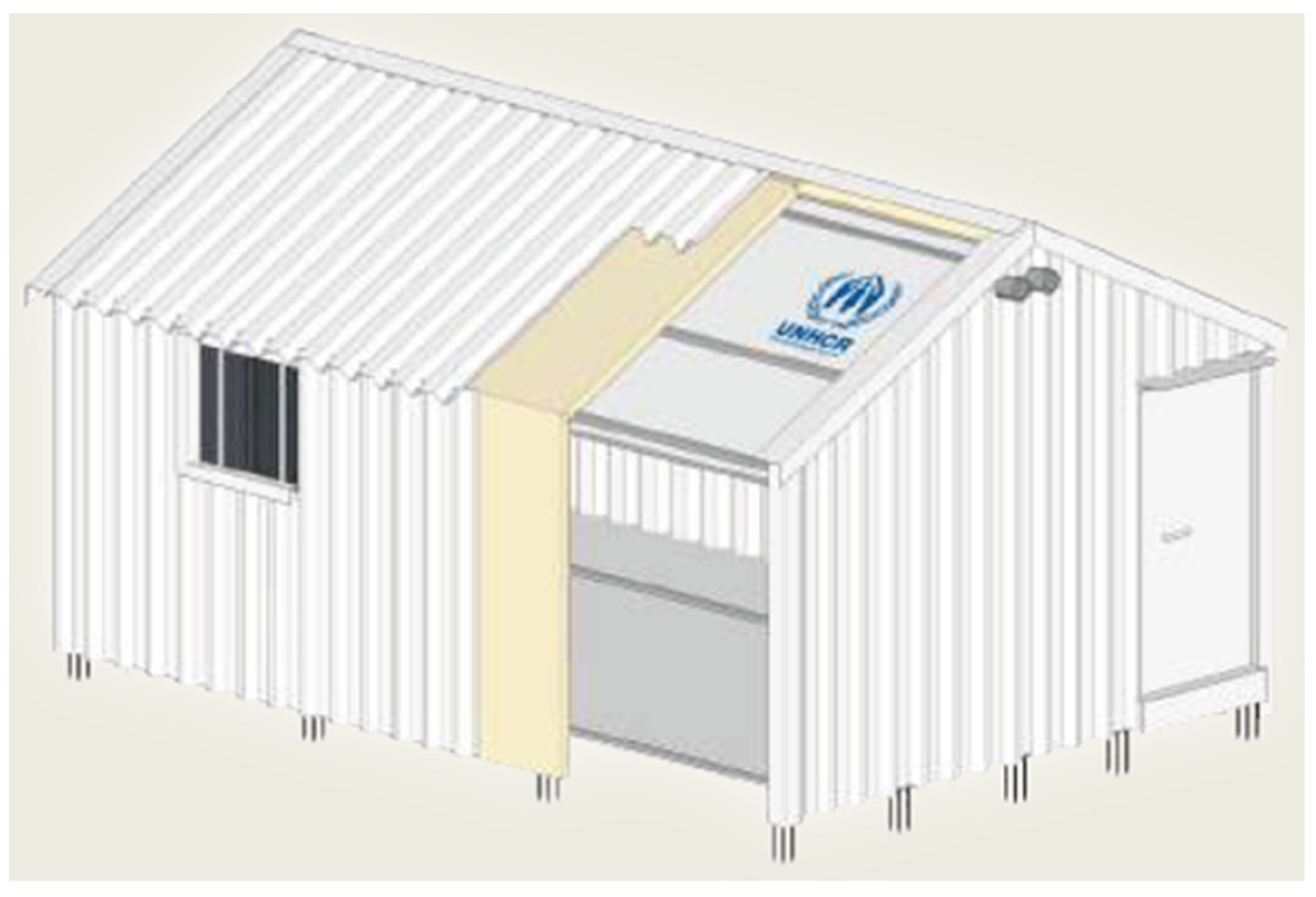
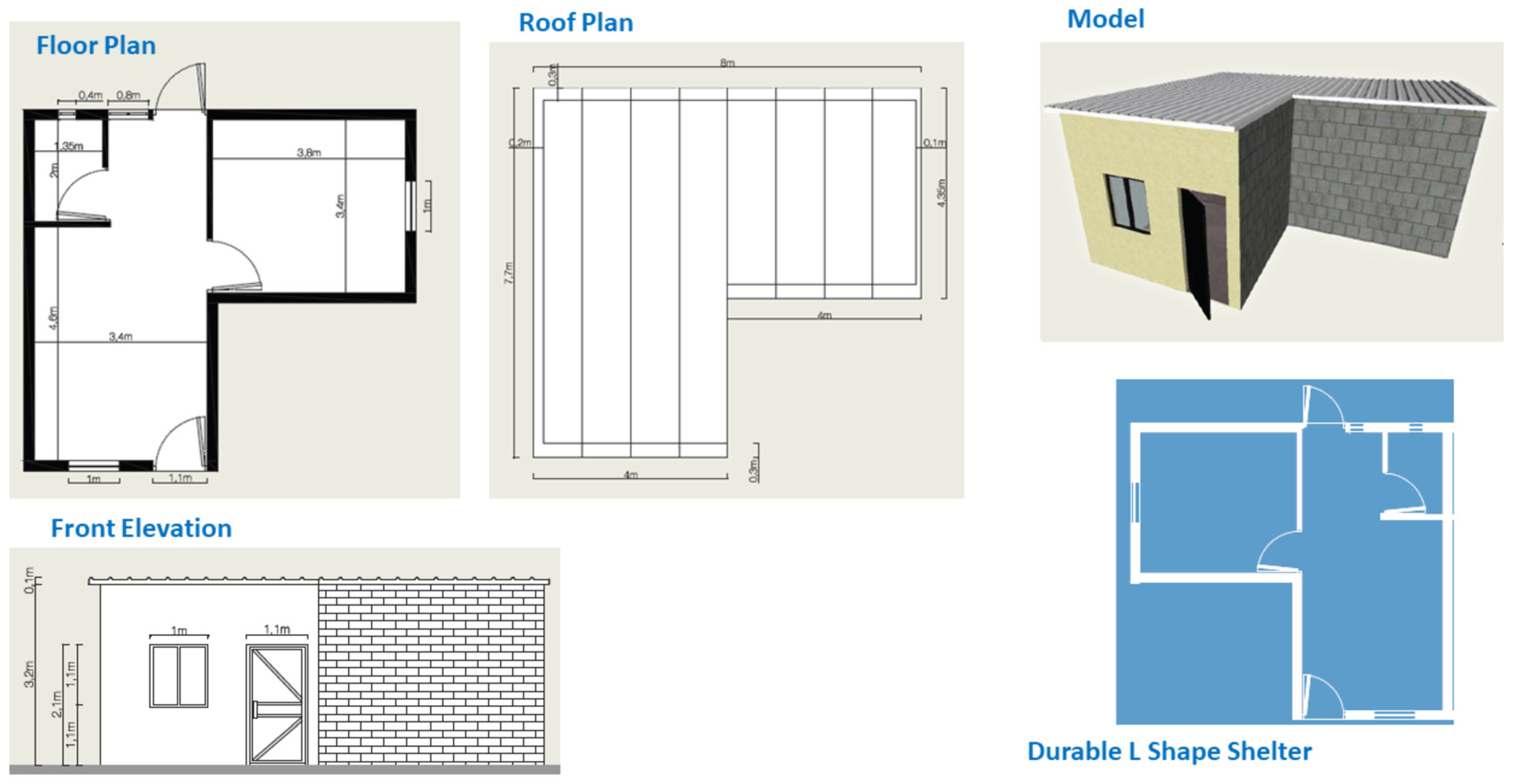


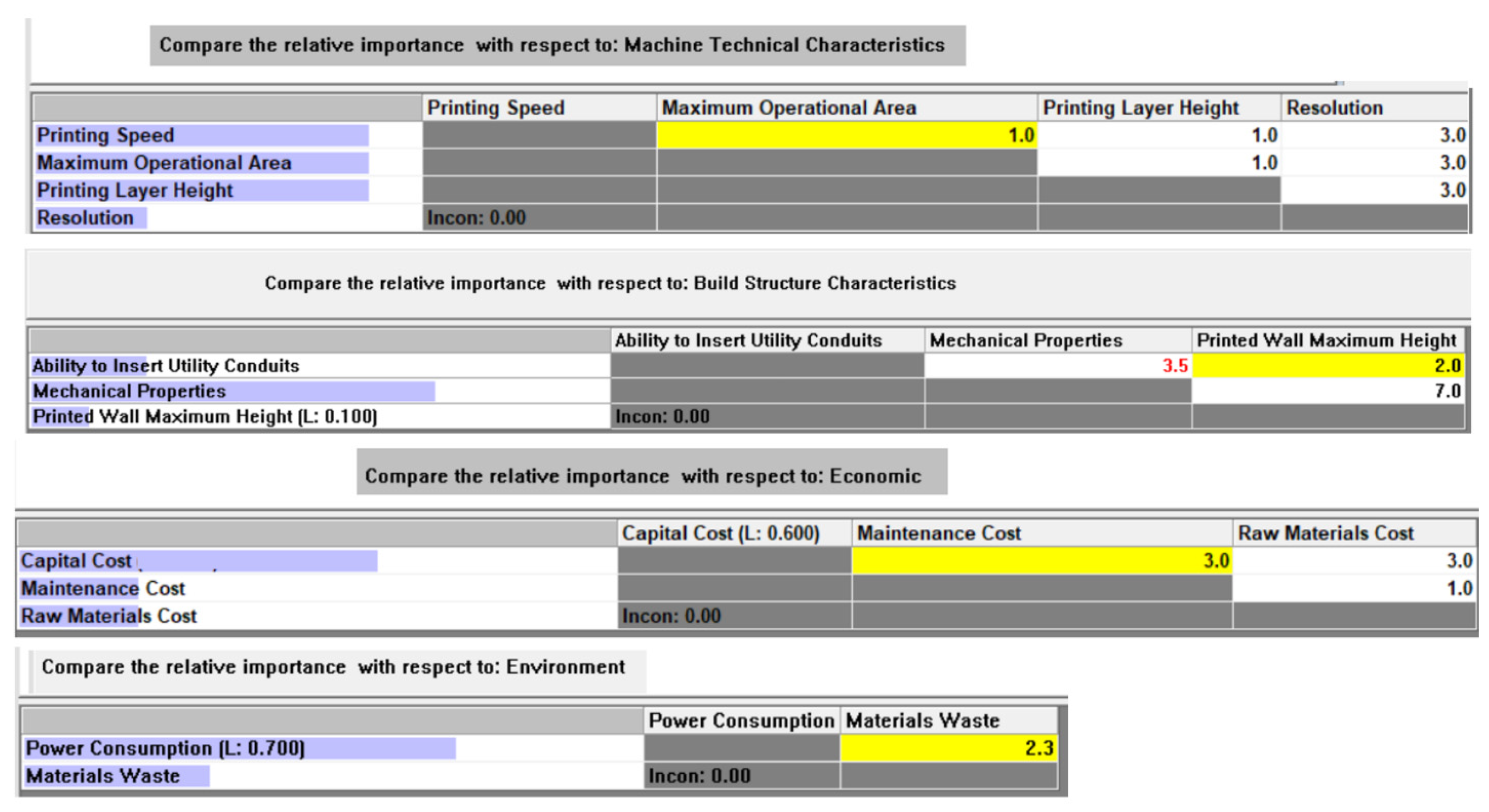
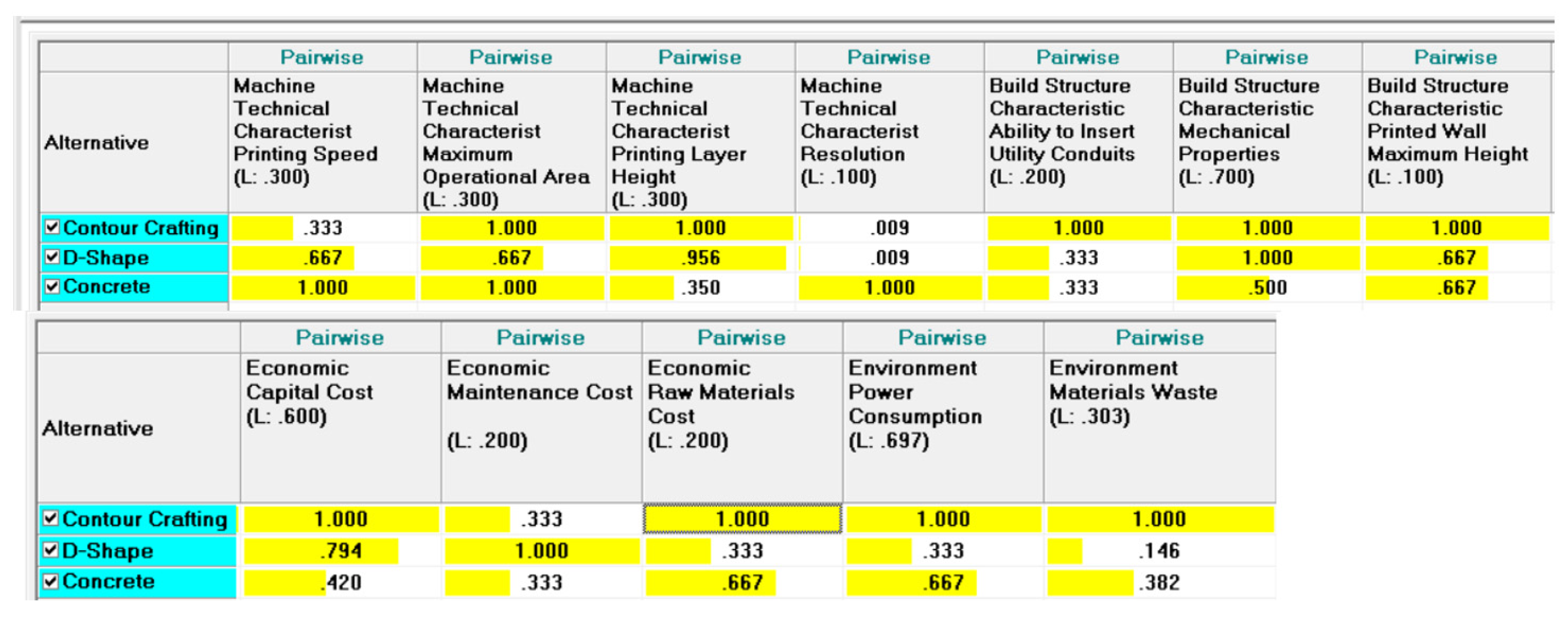

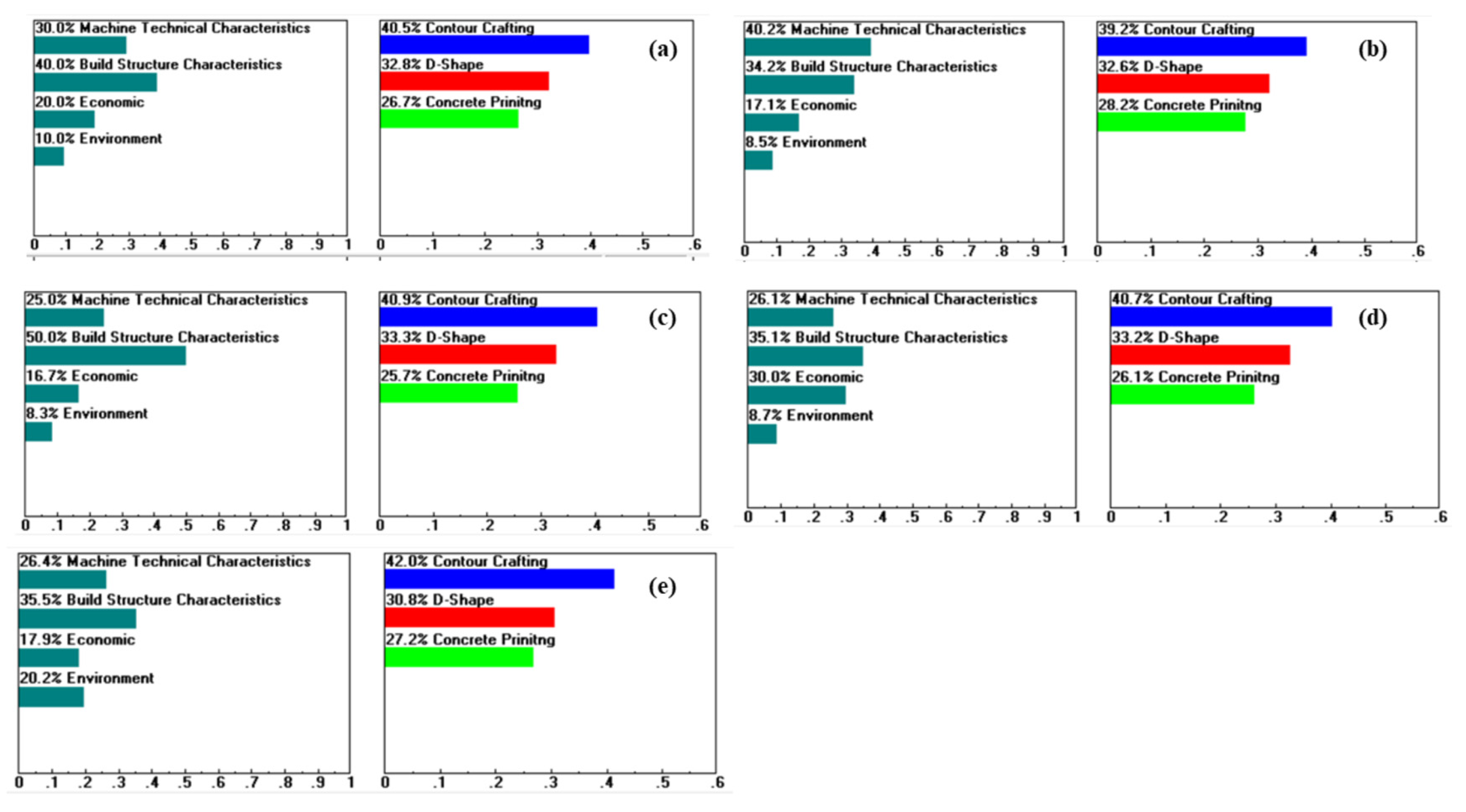
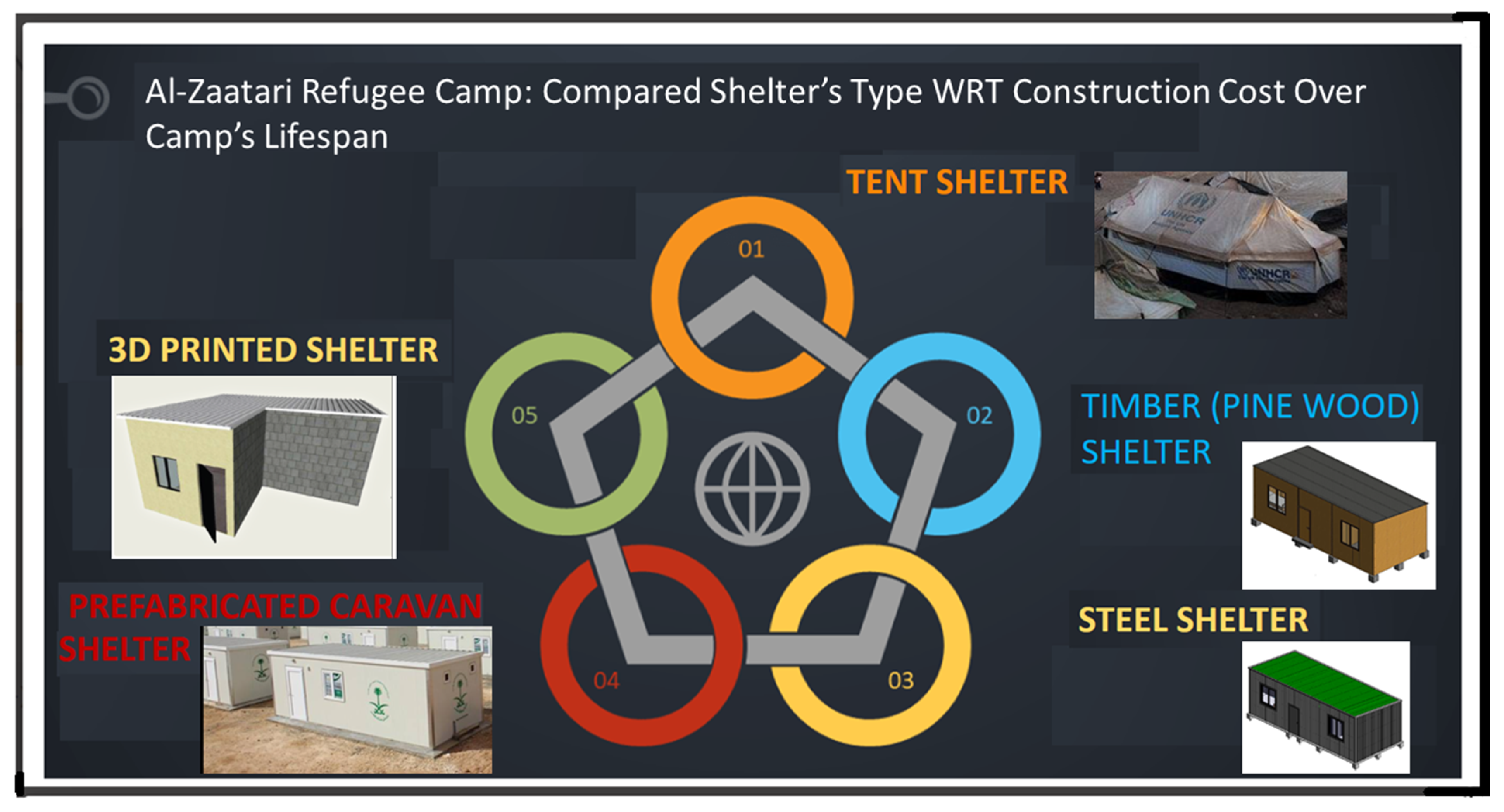
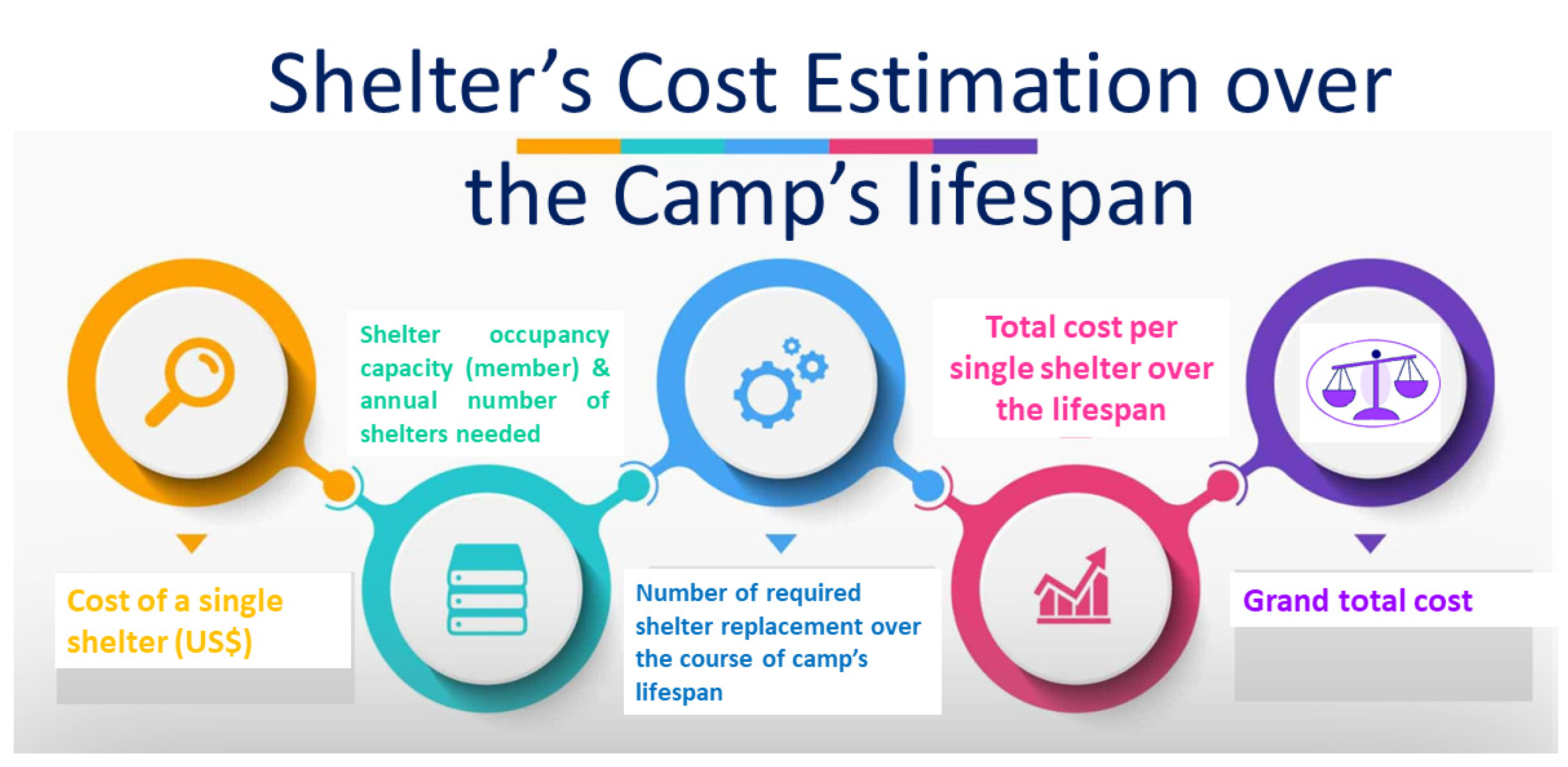
| Criteria | Sub-Criteria | Description |
|---|---|---|
| Machine characteristics | Printing speed | Maximum movement speed in the horizontal direction (mm/s). |
| Maximum operational area | A maximum size of the building structure that can be printed by a particular 3D concrete printer and encompasses all of the design. | |
| Printing layer thickness | Maximum height of the extruded concrete layer in each path travel. | |
| Resolution | The smallest detail or minimum feature size that can be built. | |
| Building structure characteristics | Mechanical properties | The mechanical performance of the produced structure, including compressive strength and interlayer bonding between extruded layers. |
| Ability to add utility conduits | The possibility of laying out the utility conduits (i.e., electrical, plumbing, sewage, HVAC work, and insulation) within the walls during printing. | |
| Printed wall maximum height | The maximum height of stable structure that can be produced by the printer. | |
| Economic impact | Capital cost | One-time expenses paid to the manufacturer to purchase the 3D printer, as well as additional expenses incurred to set up the facility to lay out the printer. |
| Maintenance cost | The costs related to maintaining the printer’s condition through routine maintenance and repairs as needed. | |
| Raw materials cost | The cost of startup materials used in the printed structure. | |
| Environment impact | Power consumption | The electrical energy per unit time, required to operate the 3D printer. |
| Materials waste | The amount of waste or unused redundant material incurred after 3d printing. |
| Criteria (C) | Sub Criteria (CS) | Required Direction of Change | 3D Concrete Printing Technology | ||
|---|---|---|---|---|---|
| Contour Crafting | D-Shape | Concrete Printing | |||
| Machine technical characteristics (C1) | Speed printing (CS11) | Maximize | Low | Medium | High |
| Maximum operational area (CS12) | Maximize | Large scale structure | Medium size structure (limited frame 6 m × 6 m × 6 m) | Large scale structure | |
| Printing layer thickness (CS13) | Maximize | 13 mm | 5–25 mm | 4–6 mm | |
| Resolution (CS14) | Maximize | Low (15 mm) | Low (9–20 mm) | High (0.13 mm) | |
| Building structure characteristics (C2) | Printed wall maximum height (CS21) | Maximize | High (3.3 m) | Medium (2 m) | Medium (2 m) |
| Ability to insert utility conduits (CS22) | Maximize | High (easy) | Low | Low | |
| Mechanical properties (strength) (CS23) | Maximize | Low bonding between layers | High strength | High strength | |
| Economic (C3) | Capital cost (CS31) | Minimize | Medium | Low | High |
| Maintenance cost (CS32) | Minimize | High (extrusion) | Low (spreading) | High (extrusion) | |
| Raw material cost (CS33) | Minimize | Low (cementitious or mortar) | High (powder materials and chemical agents) | Medium (mixed 3D-printed concrete) | |
| Environment (C4) | Power consumption (CS41) | Minimize | High | Low | Medium |
| Materials waste (CS42) | Minimize | Low | High (massive powder and redundant powder materials are needed to remove) | Medium | |
| Criteria (C) | Sub Criteria (CS) | 3D Concrete Printing Technology | ||
|---|---|---|---|---|
| Contour Crafting | D-Shape | Concrete Printing | ||
| C1 | CS11 | 3 | 6 | 9 |
| CS12 | 9 | 6 | 9 | |
| CS13 1 | 13 | 15 | 5 | |
| CS14 1 | 15 | 14.5 | 0.13 | |
| C2 | CS21 | 3.3 | 2 | 2 |
| CS22 | 9 | 3 | 3 | |
| CS23 | 3 | 6 | 6 | |
| C3 | CS31 | 6 | 3 | 9 |
| CS32 | 3 | 9 | 3 | |
| CS33 | 9 | 3 | 6 | |
| C4 | CS41 | 9 | 3 | 6 |
| CS42 | 3 | 9 | 6 | |
| 3D Concrete Printing Technology | Building Structure Characteristics (L: 0.400) | Economic (L: 0.200) | Environment (L: 0.100) | Machine Technical Characteristics (L: 0.300) | Total |
|---|---|---|---|---|---|
| Contour Crafting | 0.183 | 0.079 | 0.46 | 0.096 | 0.265 |
| D-Shape | 0.152 | 0.068 | 0.013 | 0.095 | 0.404 |
| Concrete Printing | 0.088 | 0.041 | 0.026 | 0.11 | 0.328 |
| Type of Shelter | Cost of a Single Shelter, USD | Durability | Occupancy Capacity (Members) | Number of Replacements over the Course of the Camp’s Life Span | Total Cost per Single Shelter over a 15-Years Life Span, USD | Number of Shelters Needed/Year | Cost over a 15-Year Life Span, USD | Cost Efficiency |
|---|---|---|---|---|---|---|---|---|
| Tent | 500 | 6 months | 5 | 30 | 15,000 | 16,000 | 240 M | 40% |
| Timber (pinewood) | 27,429 | 5 years | 3 | 82,288 | 10,000 | 823 M | 83% | |
| Steel | 5232 | 3 years | 5 | 26,160 | 10,000 | 262 M | 45% | |
| Prefabricated caravan | 3125 | 3 years | 6 | 5 | 15,630 | 13,500 | 211 M | 32% |
| 3D-printed | 14,395 | 15 years | 8 | 1 | 14,395 | 10,000 | 144 M |
Disclaimer/Publisher’s Note: The statements, opinions and data contained in all publications are solely those of the individual author(s) and contributor(s) and not of MDPI and/or the editor(s). MDPI and/or the editor(s) disclaim responsibility for any injury to people or property resulting from any ideas, methods, instructions or products referred to in the content. |
© 2023 by the authors. Licensee MDPI, Basel, Switzerland. This article is an open access article distributed under the terms and conditions of the Creative Commons Attribution (CC BY) license (https://creativecommons.org/licenses/by/4.0/).
Share and Cite
Almomani, M.A.; Al-Ababneh, N.; Abdalla, K.; Shbeeb, N.I.; Pantouvakis, J.-P.; Lagaros, N.D. Selecting the Best 3D Concrete Printing Technology for Refugee Camp’s Shelter Construction Using Analytical Hierarchy Process: The Case of Syrian Refugees in Jordan. Buildings 2023, 13, 1813. https://doi.org/10.3390/buildings13071813
Almomani MA, Al-Ababneh N, Abdalla K, Shbeeb NI, Pantouvakis J-P, Lagaros ND. Selecting the Best 3D Concrete Printing Technology for Refugee Camp’s Shelter Construction Using Analytical Hierarchy Process: The Case of Syrian Refugees in Jordan. Buildings. 2023; 13(7):1813. https://doi.org/10.3390/buildings13071813
Chicago/Turabian StyleAlmomani, Mohammed A., Nedal Al-Ababneh, Khairedin Abdalla, Nadim I. Shbeeb, John-Paris Pantouvakis, and Nikos D. Lagaros. 2023. "Selecting the Best 3D Concrete Printing Technology for Refugee Camp’s Shelter Construction Using Analytical Hierarchy Process: The Case of Syrian Refugees in Jordan" Buildings 13, no. 7: 1813. https://doi.org/10.3390/buildings13071813
APA StyleAlmomani, M. A., Al-Ababneh, N., Abdalla, K., Shbeeb, N. I., Pantouvakis, J.-P., & Lagaros, N. D. (2023). Selecting the Best 3D Concrete Printing Technology for Refugee Camp’s Shelter Construction Using Analytical Hierarchy Process: The Case of Syrian Refugees in Jordan. Buildings, 13(7), 1813. https://doi.org/10.3390/buildings13071813









